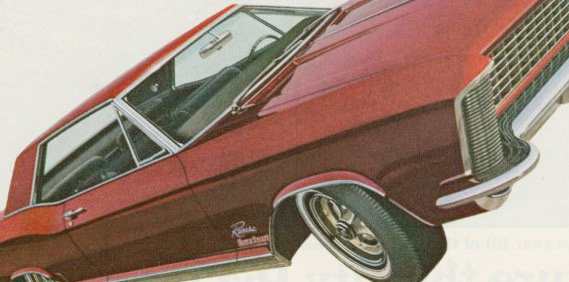The Riviera Story

The GM styling chief, Bill Mitchell, was in London on business when a vision inspired a car. It was a foggy morning and Bill woke early to sit at a small cafe located on the street next to his hotel. Just as he was taking his first sip of the scalding English coffee, a 1955 Rolls-Royce Silver Dawn athletically rounded a corner and split the fog that had settled on the street right next to him. The shapes and sounds of that brief encounter would effect Bill for the rest of his life.

However, it was only a couple of years later when GM brass came to Bill Mitchell with a problem. Ford was killing the market with their new Thunderbird and they needed something to battle it… They needed a “personal luxury car” of their own. The car had to be fast and luxurious and the overall quality had to be good enough to support the La Salle crest – Cadillac’s small companion brand from the 1930s.
Bill instantly thought back to his experience in London and began collecting pictures of mid 1950s era Rolls-Royces. He thought an Americanized version of the British beast would be perfect. A few sketches were made, a library of pictures created and when all of the “research” was completed, Bill handed it off to one of his favorite designers – Ned Nickles.
Ned and his team finished sketch after sketch only to see them all get rejected by Bill as “too much Rolls here” or “not enough Rolls there.” It wasn’t until Bill and Ned stumbled across another car from 1955 that they got their final inspiration – the 1955 Ferrari SuperAmerica. It was long, low, and sleek… a perfect compliment to the knifing lines of the Silver Dawn.

The merger was made with an attention to detail that had never been seen at GM styling and in 1962, the La Salle XP-715 prototype was shown to the world. The feedback was incredible, but Cadillac just wasn’t interested in reviving the La Salle brand and cannibalizing their record sales numbers. Buick, however, was ready to the produce the car as soon as GM gave them the green. Politics threatened to delay the project, but Bill Mitchell was determined and a deal was struck. His baby would be a Buick Riviera.
After the brand change, one last prototype was built as a production study. The 1963 Buick Riviera prototype was very similar to the XP-715, but featured two major changes: 1) The “pancaked” hood of the XP-715 was tossed for something more conventional due to production fears. 2) The headlights of the XP-715 were moved from the grille to the fenders and hidden by crossbars. The final result was an absolutely stunning car that just about everyone at GM (especially Buick) was ecstatic with.
However, production proved to be challenging. The Riviera was to be built on a frame that was shared by no other platform. This act was a real rarity for the always cost conscious General, but brass figured the Riviera was one car that could break the mold. Further, engineers found it too cost prohibitive to move the headlights from the grille to back behind the front fender bars. Bill would get his exclusive frame, but he wouldn’t get his hidden headlights – they were moved back to the grille.
The 1963 Buick Riviera was released to the public in October of 1962. Production was limited to 40,000 units in an effort to lower risk and increase demand. Although expensive (typical optioned out cars ran $5000), the Riviera was sold out in a mere 7 months. Road & Track and MotorTrend gave the car a raving review using quotes such as:
“The most roadable American car to date.”
“It’s hard to imagine a more sleek form or one that moves out quite as nimbly. The Buick Riviera is our favorite road car to ever be tested on these pages.”
For 1964, it was just more of the same for the Riviera. There were some option changes and powerplant moves, but for the most part Buick left it well enough alone. However, by 1965 Buick sales had proven themselves enough to give Bill Mitchell something he always wanted – hidden headlights. Of course, 1965 would also be the last year for the design that many believe is the most beautiful American car ever.
…………………
…….









